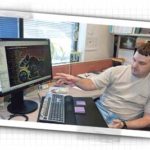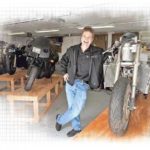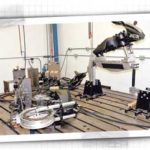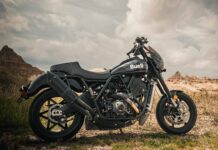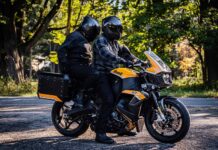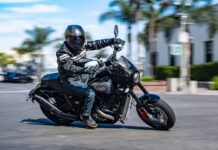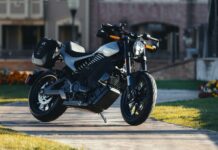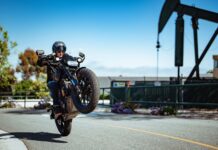From The Shed to the future
A tour of Erik Buell’s roots and the fruits of his efforts
East Troy, Wisc., June 2–3—According to Erik Buell, a prototype of the 1125R was conceived and built nearly 20 years prior to its 2007 introduction. The motorcycle to which he’s referring rests between us atop a wooden stand. It’s a cobbled piece of architecture compared to the refined products being churned out of the Buell factory, but the cutting edge elements that define modern Buells, such as a frame full of fuel and split radiators, are in place.
He says the placing of fuel in the frame solves two endurance-racing problems. The first is how to affix an air box to a V-Twin engine with enough volume to aspirate high-performance horsepower. The other is moving the weight of five gallons of fuel from a high-altitude location to a lower point in the chassis. The split radiators create room for the engine to be shifted forward for better centralization.
Unlike a modern 1125R and its more conveniently located gas cap, the fuel intake on the prototype protrudes between the upper and lower triple clamps, extending beyond the fork tubes. The split front fairing hinges forward, granting unhindered access for quick pit stops during endurance races.
Erik Buell explains all this inside what is referred to by he and the Buell proletariat as “the shed,” the three-door garage out back of the fire-gutted farmhouse built from a 1909 Sears & Roebuck catalog. There’s a more rustic barn on the far side of the lawn from the shed that holds more Buell curiosities, but we’re here to see what Erik chose to display, which, in addition to the 1125R predecessor, includes his original 160 hp, rotary square four RW 750 as well as the test mule for the V-Rod concept engine.
The same year the RW 750 graced the cover of CycleWorld magazine, the AMA Formula One race class for which it was built was unceremoniously dropped from competition, Erik Buell says sardonically. But it was this decision that turned Erik Buell’s attention to creating street-legal sportbikes made in America.
On the stand separating the 1125R prototype and the RW 750 racer sits a bike adorned with misleading Suzuki bodywork and rattle can matte black paint. The rat bike disguise was meant to hide the liquid-cooled engine under development at the time. With the fairing removed the V-Rod motor is obvious, but according to Erik Buell, that liquid-cooled twin was originally designated as a replacement for the 1203 cc air-cooled twins that had been powering Buells for years. Apparently, Harley-Davidson’s V-Rod project took precedence and in the process the new twin became unsuitable for sportbike use, forcing Erik to modify the old air-cooled V-Twins to fit the forthcoming XB series.
When a Harley exec later produced verifiable market research concluding that the public desired Buell motorcycles with liquid-cooled engines, proceeds from XB sales were channeled into producing the Rotax-built Helicon engine powering today’s 1125R and 1125CR models.
From Road X to Buell Drive
Leaving the shed, we retrace our way back down Road X, past the Mukwonago water tank to the Buell assembly plant on Buell Drive in East Troy, where we are introduced to Elvis.
Elvis is actually ELVIS, an acronym for Buell’s self-developed, integrated system of tracking damn near everything that happens within the Buell facility. It may sound like big brother, but the Electronic Linked Vital Information System is pertinent to Buell’s efficiency. Harley-Davidson was impressed enough to integrate the system into the mother ship.
ELVIS is so ubiquitous that it not only provides communication and instant access to information regarding the progress of development between departments, it also tracks important torque settings on the assembly line, ensuring that no Buell motorcycle leaves the factory with a loose screw.
A noticeable difference between the Buell assembly line and that of larger manufacturers is the absence of robots. Human hands construct each Buell model. Efficiency is key and each station is timed. A quick look at the ELVIS monitor tells the number of bikes produced for the day, week or month, where they are in the production schedule and a seemingly endless list of other vital information.
Three of 11
A breakdown of Buell’s product development process reveals 11 individual departments, but access to the Testing, Analysis and Design sections is all Buell is allowing on this trip.
A couple of interesting elements of the Test Engineering department are the biaxial test machine and the electrodynamic shaker. The biaxial test machine determines stress limitations on the front end assembly of Buell motorcycles by literally shaking the hell out of ’em, simulating years of fatigue in a matter of days. The bike, lying on its side, is being subjected to what is in effect a super stoppie every five seconds. Watching the small dial gauge register the amount of fork flex, I step aside just in case structural limitations are breached.
The electrodynamic shaker sits in a soundproof room with an inverted engine attached. Both the engine and exhaust system are being bombarded by high-frequency vibrations. You only enter the room with a good pair of sound-deadening earmuffs and touching the test subjects is akin to scratching your fingernails across a vibrating chalkboard.
In the Analysis Department big words such as Computational Fluid Dynamics are used to describe technology that translates to a virtual wind tunnel. The computer software exposes areas of high-pressure that determine placement of such items as the ram-air intake on the 1125R. The software also analyzes unsprung weight and how it affects handling, then helps determine the design of components such as wheels. (And you thought the 1125R wheels were sculpted by stylists.) 1125R wheels actually differ on the right and left side, the right featuring tight tolerances for clearance of the brake caliper.
Design is separated into the air- and liquid-cooled departments. Both areas work closely with Analysis when constructing new components. When design and analysis parameters are met, a new Buell chassis can be sent out for rapid prototyping and returned within days as a full-size plastic representation of the part before costly tooling is initiated.
The Buell racing facility is a brief stroll (seemingly much longer in wintertime) down the street from the main building. Here is where the magic is happening for the race-winning 1125R in the AMA Pro Daytona SportBike class (see sidebar).
Information gained under the stress of racing is data logged, downloaded and shared with the Design and Analysis departments, who analyze the information and apply modifications to increase the performance of the race machines. Successful gains are then implemented back into the streetbikes.
The entire Buell outfit is small, but considering the amount of progress Buell has realized in the past decade its efficiency is paying off. As America’s only sportbike manufacturer with a tradition of producing untraditional motorcycles Erik Buell and his employees exude excitement about the future of the company and pride in what has already been accomplished. It’s a short distance to the shed where Buell began, but a long way from that handmade prototype.


